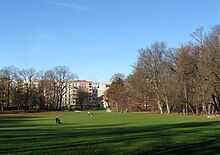Bavariapark
The Bavariapark (also exhibition park ) in Munich has an area of 6.8 hectares and is a monument according to the Bavarian Monument Protection Act . It is located behind the Bavaria statue and the Hall of Fame on Theresienwiese in the Schwanthalerhöhe (or Westend) district. After the trade fair moved to the trade fair town of Riem , the entire area around the park was redesigned and the Bavariapark has been open to the public again since 1999.
history
Emergence
Initially the Bavariapark was called “Theresienhain”. Between 1825 and 1831, at the instigation of King Ludwig I , the court gardener Seitz planted it with oaks as a grove-like park in front of the city gates of Munich and formed the creative and ideal framework for the Hall of Fame, which, based on designs by Leo von Klenze, was built over the Theresienwiese until 1853 was built. When the Bavaria statue was inaugurated in 1850, the “Theresienhain” was given its current name. However, it did not become publicly accessible until 1872 - with walking paths, the "King Ludwigs Hill" and an unspoilt tree population at the time.
Conversion into an exhibition park
When the Theresienhöhe was further developed, it was realized that the architectural appearance of the Hall of Fame had to be protected. Since the area in connection with the Theresienwiese should serve for future large exhibitions, the Bavariapark was integrated into the exhibition area in the plans of Prof. Gabriel von Seidl , which was inaugurated with the large exhibition "Munich 1908". For this purpose, the path system of the park had to be adapted by adding new walking paths. In addition, the tree population was rejuvenated through new planting. What was largely preserved, however, was the extensive park meadow and the Ludwigshügel as a design element. At the same time, the Bavariapark was cut through by the construction of a road - the Bavariaring , which surrounds the Theresienwiese.
As part of this conversion into an “exhibition park”, a grove of figures and sculptures by artists from Munich at the time were integrated. There was also an arcade and a cascade fountain. The changes in the 1920s and 1950s were mainly based on the historical inventory, which changed in the 1960s and 1970s: From now on, such historically oriented garden aesthetic considerations played a lesser role, which led to equipment elements being removed and various figures got a new place within the park.
The sculptures and sculptures created in 1907/08 include:
- "Lying source nymph", by Heinrich Düll a . Georg Pezold
- "Resting Faun", by Cipri Adolf Bermann
- Rider group
- “Reichtum” (youth on manatee), by Bernhard Bleeker
- "Beauty" (virgin on unicorn), by Hermann Hahn
- "Fantasy" (rider on a horse), by Carl Ebbinghaus
- "Kraft" (Hercules on Bull), by Fritz Behn
- Bronze group "Wild Horses", by Georg Roemer
- Bronzehirsch, by Theodor Georgii
- Female Herme with a well basin, by Heinrich Düll a . Georg Pezold
Some of the sculptures and sculptures originally created for the exhibition park are still standing today. a. in the Hellabrunn Zoo , on Orleansplatz and in the Munich City Museum .
Redesign 2007/2008
When the trade fair moved to Riem, the Theresienhöhe could be reorganized in terms of urban planning. It was clear that the Bavariapark should be freely accessible again as a public green area in the future , which was made possible in 1999. When new residential and office buildings were built in the west and south of the park in the following years, the park was increasingly used for recreation and relaxation.
Nowadays the park meadow is ideal for ball games and picnics. Joggers, dog owners and walkers cavort on the circular paths and families are drawn to a newly created children's playground.
In the more isolated parts of the park, nature observations are even possible, so that school classes can also be found here as part of their natural history lessons, because the Bavariapark is an important biotope that is home to many protected animal species due to its extensive old tree population.
Finally, the building department of the city of Munich commissioned a development and maintenance concept (“ Parkpflegewerk ”) that focused on sustainability considerations. On the basis of this concept, many reconstruction and repair measures were carried out in 2007. Overdue maintenance cuts were also made on the crop. In addition, around 500 bushes and 36 large trees were newly planted. These measures were financed from the special reserve for the urban development measure “Theresienhöhe”.
Web links
Coordinates: 48 ° 7 '52.1 " N , 11 ° 32' 33.7" E




